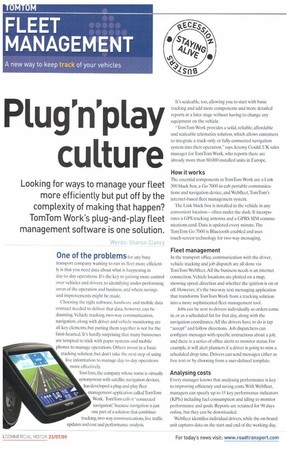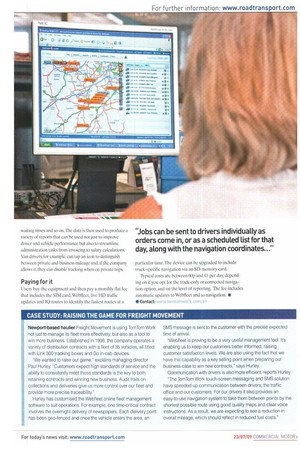Plug'n'play culture
Page 44

Page 45

If you've noticed an error in this article please click here to report it so we can fix it.
Looking for ways to manage your fleet more efficiently but put off by the complexity of making that happen? TomTom Work's plug-and-play fleet management software is one solution.
One of the problems for any busy transport company wanting to run its fleet more efficiently is that you need data about what is happening in day-to-day operations. It's the key to gaining more control over vehicles and drivers, to identifying under-performing areas of the operation and business, and where savings and improvements might he made.
Choosing the right software, hardware and mobile data contract needed to deliver that data, however, can be daunting. Vehicle tracking, two-way communication, navigation, along with driver and vehicle monitoring arc all key elements, hut putting them together is not for the faint-hearted. It's hardly surprising that many businesses are tempted to stick with paper systems and mobile phones to manage operations. Others invest in a basic tracking solution, but don't take the next step of using live information to manage day-to-day operations more effectively.
TomTom, the company whose name is virtually synonymous with satellite navigation devices, has developed a plug-and-play fleet management application called TomTom Work. TomTom calls it "connected navigation'," because navigation is just one part of a solution that combines tracking, two-way communications, live traffic updates and cost and performance analysis. It's scaleable, too, allowing you to start with basic tracking and add more components and more detailed reports at a later stage without having to change any equipment on the vehicle.
"TomTom Work provides a solid, reliable, affordable and scaleable telematics solution, which allows customers to integrate a track-only or fully-connected navigation system into their operation," says Jeremy Gould, UK sales manager for TomTom Work, who reports there arc already more than 80.000 installed units in Europe.
How it works The essential components in TomTom Work are a Link 300 black box, a Go 7000 in-cab portable communications and navigation device, and Webfleet,TomTom's intemet-based fleet management system.
lbe Link black box is installed in the vehicle in any convenient location — often under the dash. It incorporates a GPS tracking antenna and a GPRS SIM communications card. Data is updated every minute. The TomTom Go 7000 is Bluetooth-enabled and uses touch-screen technology for two-way messaging.
Fleet management In the transport office, communication with the driver, vehicle tracking and job dispatch are all done via TomTom Webtleet. All the business needs is an internet connection. Vehicle locations are plotted on a map, showing speed, direction and whether the ignition is on or off. However, it's the two-way text messaging application that transforms TomTom Work from a tracking solution into a more sophisticated fleet management tool.
Jobs can be sent to drivers individually as orders come in, or as a scheduled list for that day, along with the navigation coordinates. All the drivers have to do is tap "accept" and follow directions Job dispatchers can configure messages with specific instructions about a job, and there is a series of office alerts to monitor status. For example, it will alert planners if a driver is going to miss a scheduled drop time. Drivers can send messages either as free text or by choosing from a user-defined template.
Analysing costs Every manager knows that analysing performance is key to improving efficiency and saving costs. With Webfleet, managers can specify up to 15 key performance indicators (KPIs) including fuel consumption and idling to monitor performance and goals. Reports are retained for 90 days online, but they can be downloaded.
Webfleet identifies individual drivers, while the on-board unit captures data on the start and end of the working day, waiting times and so on. The data is then used to produce a variety of reports that can be used not just to improve driver and vehicle performance but also to streamline administration tasks from invoicing to salary calculations. Van drivers, for example, can tap an icon to distinguish between private and business mileage and, if the company allows it, they can disable tracking when on private trips.
Paying for it
Users buy the equipment and then pay a monthly flat fee that includes the SIM card,Webileet, live HD traffic updates and IQ routes to identify the fastest routes at a particular time. The device can be upgraded to include truck-specific navigation via an SD memory card.
Typical costs are between 60p and Ll per day, depending on if you opt for the track-only or connected navigation option, and on the level of reporting. The fee includes automatic updates to Webfleet and to navigation. •
• Contact:








































































































































